NPC Based Design Optimization for a Net Zero Office Building in Hot Climates with PV Panels as Shading Device
Abstract
1. Introduction
2. Methodology
- ➢
- Off-grid hybrid energy system for building with no shading (NS) rooftop by PV arrays to show the benefit of the grid-connected system
- ➢
- NZEB with NS on the rooftop with only solar resources
- ➢
- NZEB with NS on the rooftop with only wind resources
- ➢
- NZEB with NS on the rooftop with solar and wind resources
- ➢
- NZEB with fully shaded (FS) rooftop by PV arrays without using wind resources
- ➢
- NZEB with FS rooftop by PV arrays using wind resources
3. Case Study Analysis
3.1. Renewable Resources
3.2. PV Self-Shading Analysis
3.3. Shading Effect on Cooling Load of Building Analysis
4. Net-Zero Energy Analysis
- Scenario 1
- Off-grid with NS hybrid solar and wind energy system
- Scenario 2
- NZEB with NS with PV only
- Scenario 3
- NZEB with NS with wind only
- Scenario 4
- NZEB with NS with hybrid solar and wind energy system
- Scenario 5
- NZEB with FS rooftop with PV only
- Scenario 6
- NZEB with FS rooftop with hybrid solar and wind energy system
4.1. Energy Analysis
4.2. Economics Analysis
5. Conclusions
Author Contributions
Acknowledgments
Conflicts of Interest
Nomenclature
| NZEB | Net Zero Energy Building |
| PV | Photovoltaic |
| NPC | Net Present Cost |
| FS | Fully Shaded |
| NS | No Shading |
| SAM | System Advisor Model |
| The convective heat transfer coefficient | |
| Surface temperature of rooftop | |
| Outside air temperature of rooftop | |
| Is the output of the PV array | |
| The rated capacity of the PV array, meaning its power output under standard test conditions [kW] | |
| The PV derating factor [%] | |
| Solar radiation incident on the PV array in the current time step [kw/m2] | |
| Incident radiation at standard test conditions [1 kw/m2] | |
| Temperature coefficient of power [%/°C] | |
| PV cell temperature in the current time step [°C] | |
| PV cell temperature under standard test conditions [25 °C] | |
| Long wave emittance | |
| Stefan-Boltzmann constant | |
| View factor of the rooftop surface to PV surface [Range: 0–1] | |
| View factor of the rooftop surface to sky [Range: 0–1] | |
| View factor of the rooftop surface to air [Range: 0–1] | |
| Temperature of PV | |
| Temperature of air | |
| Temperature of sky | |
| Temperature of the rooftop | |
| EPC | Engineering procurement and construction |
| O&M | Operation and maintenance |
| IDO | Cost, insurance during operation |
| IDC | Insurance during construction |
| PDC | Project development cost |
| ROE | Return on equity |
| CoE | College of Engineering |
| LCOE | Levelized cost of energy (US$/kwh) |
References
- Kreft, S.; Eckstein, D.; Melchior, I. Global Climate Risk Index 2017 Who Suffers Most from Extreme Weather Events? Weather-Related Loss Events in 2015 and 1996 to 2015; Germanwatch e.V.: Bonn, Germany, 2017. [Google Scholar]
- Lesk, C.; Rowhani, P.; Ramankutty, N. Influence of extreme weather disasters on global crop production. Nature 2016, 529, 84–87. [Google Scholar] [CrossRef] [PubMed]
- Naumann, G.; Alfieri, L.; Wyser, K.; Mentaschi, L.; Betts, R.A.; Carrao, H.; Spinoni, J.; Vogt, J.; Feyen, L. Global Changes in Drought Conditions under Different Levels of Warming. Geophys. Res. Lett. 2018. [Google Scholar] [CrossRef]
- Spliethoff, H. Effect of Slag, Ash and Flue Gas on Furnace Walls and Convective Heat Transfer Surfaces (Operational Problems); Academic Press: Cambridge, MA, USA, 2010; ISBN 9780874216561. [Google Scholar]
- Oreskes, N. The Scientific Consensus on Climate Change: How Do We Know We’re Not Wrong? In Climate Modelling; Springer International Publishing: Cham, Switzerland, 2018; Volume 306, pp. 31–64. [Google Scholar]
- United Nations Paris Agreement, FCCC/CP/2015/L.9. Available online: https://unfccc.int/resource/docs/2015/cop21/eng/l09r01.pdf (accessed on 12 January 2018).
- Directive No. 2009/28/EC of the European Parliament and of the Council of 23 April 2009, on the Promotion of the Use of Energy from Renewable Sources and Amending and Subsequently Repealing Directives No. 2001/77/EC and No. 2003/30/EC. © European Union, 1998–2015. Available online: http://www.wipo.int/wipolex/en/details.jsp?id=15751 (accessed on 12 January 2018).
- Yamada, M. Vision 2030 and the Birth of Saudi Solar Energy; Middle East Institute: Washinton, DC, USA, 2016. [Google Scholar]
- Government of Saudi Arabia a Renewable Energy Market, Saudi Arabia Vision 2030. Available online: http://vision2030.gov.sa/en/node/87 (accessed on 12 January 2018).
- Awan, A.B.; Zubair, M.; Praveen, R.P.; Abokhalil, A.G. Solar Energy Resource Analysis and Evaluation of Photovoltaic System Performance in Various Regions of Saudi Arabia. Sustainability 2018, 10, 1129. [Google Scholar] [CrossRef]
- Khan, H.; Asif, M. Impact of Green Roof and Orientation on the Energy Performance of Buildings: A Case Study from Saudi Arabia. Sustainability 2017, 9, 640. [Google Scholar] [CrossRef]
- BNE Finance. Global Trends in Renewable Energy Investment; Frankfurt School: Frankfurt am Main, Germany, 2018. [Google Scholar]
- Power, A. ACWA Power Wins the First Ever Utility Scale Renewable Energy Project in Saudi Arabia. Available online: http://www.acwapower.com/en/news/press-releases/acwa-power-wins-the-first-ever-utility-scale-renewable-energy-project-in-saudi-arabia/ (accessed on 9 April 2018).
- Bloomberg Saudis, SoftBank Plan World’s Largest Solar Project. Available online: https://www.bloomberg.com/news/articles/2018-03-28/saudi-arabia-softbank-ink-deal-on-200-billion-solar-project (accessed on 9 April 2018).
- He, Z.; Xiao, B.; Liu, F.; Wu, H.; Yang, Y.; Xiao, S.; Wang, C.; Russell, T.P.; Cao, Y. Single-junction polymer solar cells with high efficiency and photovoltage. Nat. Photonics 2015, 9, 174–179. [Google Scholar] [CrossRef]
- Li, W.; Hendriks, K.H.; Furlan, A.; Wienk, M.M.; Janssen, R.A.J. High quantum efficiencies in polymer solar cells at energy losses below 0.6 eV. J. Am. Chem. Soc. 2015, 137, 2231–2234. [Google Scholar] [CrossRef] [PubMed]
- Green, M.A. Thin-film solar cells: Review of materials, technologies and commercial status. J. Mater. Sci. 2007. [Google Scholar] [CrossRef]
- Zubair, M.; Mustafa, M.; Lee, K.; Yoon, C.; Doh, Y.H.; Choi, K.H. Fabrication of CdSe/ZnS quantum dots thin film by electrohydrodynamics atomization technique for solution based flexible hybrid OLED application. Chem. Eng. J. 2014, 253, 325–331. [Google Scholar] [CrossRef]
- Yoshikawa, K.; Kawasaki, H.; Yoshida, W.; Irie, T.; Konishi, K.; Nakano, K.; Uto, T.; Adachi, D.; Kanematsu, M.; Uzu, H.; et al. Silicon heterojunction solar cell with interdigitated back contacts for a photoconversion efficiency over 26%. Nat. Energy 2017, 2, 17032. [Google Scholar] [CrossRef]
- Cariou, R.; Benick, J.; Feldmann, F.; Höhn, O.; Hauser, H.; Beutel, P.; Razek, N.; Wimplinger, M.; Bläsi, B.; Lackner, D.; et al. III–V-on-silicon solar cells reaching 33% photoconversion efficiency in two-terminal configuration. Nat. Energy 2018, 3, 326–333. [Google Scholar] [CrossRef]
- Kato, T.; Handa, A.; Yagioka, T.; Matsuura, T.; Yamamoto, K.; Higashi, S.; Wu, J.L.; Tai, K.F.; Hiroi, H.; Yoshiyama, T.; et al. Enhanced Efficiency of Cd-Free Cu(In,Ga)(Se,S)2Minimodule Via (Zn,Mg)O Second Buffer Layer and Alkali Metal Post-Treatment. IEEE J. Photovolta. 2017, 7, 1773–1780. [Google Scholar] [CrossRef]
- NREL PV Efficiency Chart. Available online: https://www.nrel.gov/pv/assets/images/efficiency-chart.png (accessed on 10 April 2018).
- Green, M.A.; Hishikawa, Y.; Dunlop, E.D.; Levi, D.H.; Hohl-Ebinger, J.; Ho-Baillie, A.W.Y. Solar cell efficiency tables (version 51). Prog. Photovolt. Res. Appl. 2018, 26, 3–12. [Google Scholar] [CrossRef]
- Kurtz, S.; Repins, I.; Metzger, W.K.; Verlinden, P.J.; Huang, S.; Bowden, S.; Tappan, I.; Emery, K.; Kazmerski, L.L.; Levi, D. Historical Analysis of Champion Photovoltaic Module Efficiencies. IEEE J. Photovolt. 2018, 8, 363–372. [Google Scholar] [CrossRef]
- Frankfurt School and UNEP Global Trends in Renewable Energy; Frankfurt School: Frankfurt am Main, Germany, 2016; pp. 1–84.
- Fu, R.; Chung, D.; Lowder, T.; Feldman, D.; Ardani, K.; Fu, R.; Chung, D.; Lowder, T.; Feldman, D.; Ardani, K.U.S. Solar Photovoltaic System Cost Benchmark: Q1 2017 U.S. Solar Photovoltaic System Cost Benchmark: Q1 2017. Nrel 2017. [Google Scholar] [CrossRef]
- Breyer, C.; Bogdanov, D.; Aghahosseini, A.; Gulagi, A.; Child, M.; Oyewo, A.S.; Farfan, J.; Sadovskaia, K.; Vainikka, P. Solar photovoltaics demand for the global energy transition in the power sector. Prog. Photovolta. Res. Appl. 2017, 1–19. [Google Scholar] [CrossRef]
- Praveen, R.P.; Baseer, M.A.; Awan, A.B.; Zubair, M. Performance Analysis and Optimization of a Parabolic Trough Solar Power Plant in the Middle East Region. Energies 2018, 11, 741. [Google Scholar] [CrossRef]
- Awan, A.B.; Khan, Z.A. Recent progress in renewable energy—Remedy of energy crisis in Pakistan. Renew. Sustain. Energy Rev. 2014, 33, 236–253. [Google Scholar] [CrossRef]
- Farnoosh, A.; Lantz, F.; Percebois, J. Electricity generation analyses in an oil-exporting country: Transition to non-fossil fuel based power units in Saudi Arabia. Energy 2014, 69, 299–308. [Google Scholar] [CrossRef]
- Fattouh, B. Summer Again: The Swing in Oil Demand in Saudi Bassam Fattouh; Oxford Energy Comment; The Oxford Institute for Energy Studies: Oxford, UK, 2013; pp. 1–8. [Google Scholar]
- Collins, R.D.; Gowharji, W.; Habib, A.; Alwajeeh, R.; Stephen, R. Evaluating scenarios of capacity expansion given high seasonal variability of electricity demand: The case of Saudi Arabia. In Proceedings of the 31st International Conference of the System Dynamics Society, Cambridge, MA, USA, 21–25 July 2013; pp. 1–15. [Google Scholar]
- Rafique, M.M.; Rehman, S.; Lashin, A.; Al Arifi, N. Analysis of a solar cooling system for climatic conditions of five different cities of Saudi Arabia. Energies 2016, 9, 75. [Google Scholar] [CrossRef]
- Cellura, M.; Campanella, L.; Ciulla, G.; Guarino, F.; Lo Brano, V.; Cesarini, D.N.; Orioli, A. The redesign of an Italian building to reach net zero energy performances: A case study of the SHC Task 40-ECBCS Annex 52. Presented at ASHRAE Transactions, Montreal, QC, Canada, 1 July 2011. [Google Scholar]
- Mohamed, A.; Hasan, A.; Sirén, K. Fulfillment of net-zero energy building (NZEB) with four metrics in a single family house with different heating alternatives. Appl. Energy 2014, 114, 385–399. [Google Scholar] [CrossRef]
- Kilkiş, Ş. Energy system analysis of a pilot net-zero exergy district. Energy Convers. Manag. 2014, 87, 1077–1092. [Google Scholar] [CrossRef]
- Kolokotsa, D.; Rovas, D.; Kosmatopoulos, E.; Kalaitzakis, K. A roadmap towards intelligent net zero- and positive-energy buildings. Sol. Energy 2011. [Google Scholar] [CrossRef]
- Wells, L.; Rismanchi, B.; Aye, L. A review of Net Zero Energy Buildings with reflections on the Australian context. Energy Build. 2018, 158, 616–628. [Google Scholar] [CrossRef]
- Doroudchi, E.; Alanne, K.; Okur, Ö.; Kyyrä, J.; Lehtonen, M. Approaching net zero energy housing through integrated EV. Sustain. Cities Soc. 2018, 38, 534–542. [Google Scholar] [CrossRef]
- Tsangrassoulis, A.; Li, D.H.W. Energy efficient lighting strategies in buildings. Energy Build. 2018, 165, 284–285. [Google Scholar] [CrossRef]
- Gobbato, C.; Kohler, S.V.; de Souza, I.H.; Denardin, G.W.; de Pelegrini Lopes, J. Integrated Topology of DC-DC Converter for LED Street Lighting System Based on Modular Drivers. IEEE Trans. Ind. Appl. 2018, 9994. [Google Scholar] [CrossRef]
- Al Dakheel, J.; Tabet Aoul, K. Building Applications, Opportunities and Challenges of Active Shading Systems: A State-of-the-Art Review. Energies 2017, 10, 1672. [Google Scholar] [CrossRef]
- Kirimtat, A.; Koyunbaba, B.K.; Chatzikonstantinou, I.; Sariyildiz, S. Review of simulation modeling for shading devices in buildings. Renew. Sustain. Energy Rev. 2016, 53, 23–49. [Google Scholar] [CrossRef]
- Peng, L.L.H.; Jim, C.Y. Green-roof effects on neighborhood microclimate and human thermal sensation. Energies 2013, 6, 598–618. [Google Scholar] [CrossRef]
- Dominguez, A.; Kleissl, J.; Luvall, J.C. Effects of solar photovoltaic panels on roof heat transfer. Sol. Energy 2011, 85, 2244–2255. [Google Scholar] [CrossRef]
- Kim, J.H.; Kim, H.R.; Kim, J.T. Analysis of photovoltaic applications in zero energy building cases of IEA SHC/EBC Task 40/Annex 52. Sustainability 2015, 7, 8782–8800. [Google Scholar] [CrossRef]
- NASA NASA Surface Meteorology and Solar Energy. Available online: https://eosweb.larc.nasa.gov/cgi-bin/sse/grid.cgi?&num=178144&lat=53&submit=Submit&hgt=100&veg=17&sitelev=&email=luke.s@wildmail.com&p=grid_id&step=2&lon=-3 (accessed on 1 April 2018).
- Scherba, A.; Sailor, D.J.; Rosenstiel, T.N.; Wamser, C.C. Modeling impacts of roof reflectivity, integrated photovoltaic panels and green roof systems on sensible heat flux into the urban environment. Build. Environ. 2011, 46, 2542–2551. [Google Scholar] [CrossRef]
- NREL. EnergyPlus Engineering Reference; NREL: Golden, CO, USA, 2018; pp. 1–1716.
- EnergySage. Solar Marketplace Intel Report H1 H2 2017; EnergySage: San Francisco, CA, USA, 2018. [Google Scholar]
- NTDC. Upfront Generation Tariff for Solar PV Power Plants and Wind Turbines; NTDC: Lahore, Pakistan, 2018; p. 63. [Google Scholar]
- Electricity & Cogeneration Regulatory Authority (ECRA). Annual Statistical Booklet for Electricity and Seawater Desalination Industries 2016; ECRA: Riyadh, Saudi Arabia, 2016.
- Almasoud, A.H.; Gandayh, H.M. Future of solar energy in Saudi Arabia. J. King Saud Univ. Eng. Sci. 2015, 27, 153–157. [Google Scholar] [CrossRef]
- Saudi Electric Company. Electrical Data 2000–2014; Saudi Electric Company: Cambridge, UK, 2014; Volume 1. [Google Scholar]




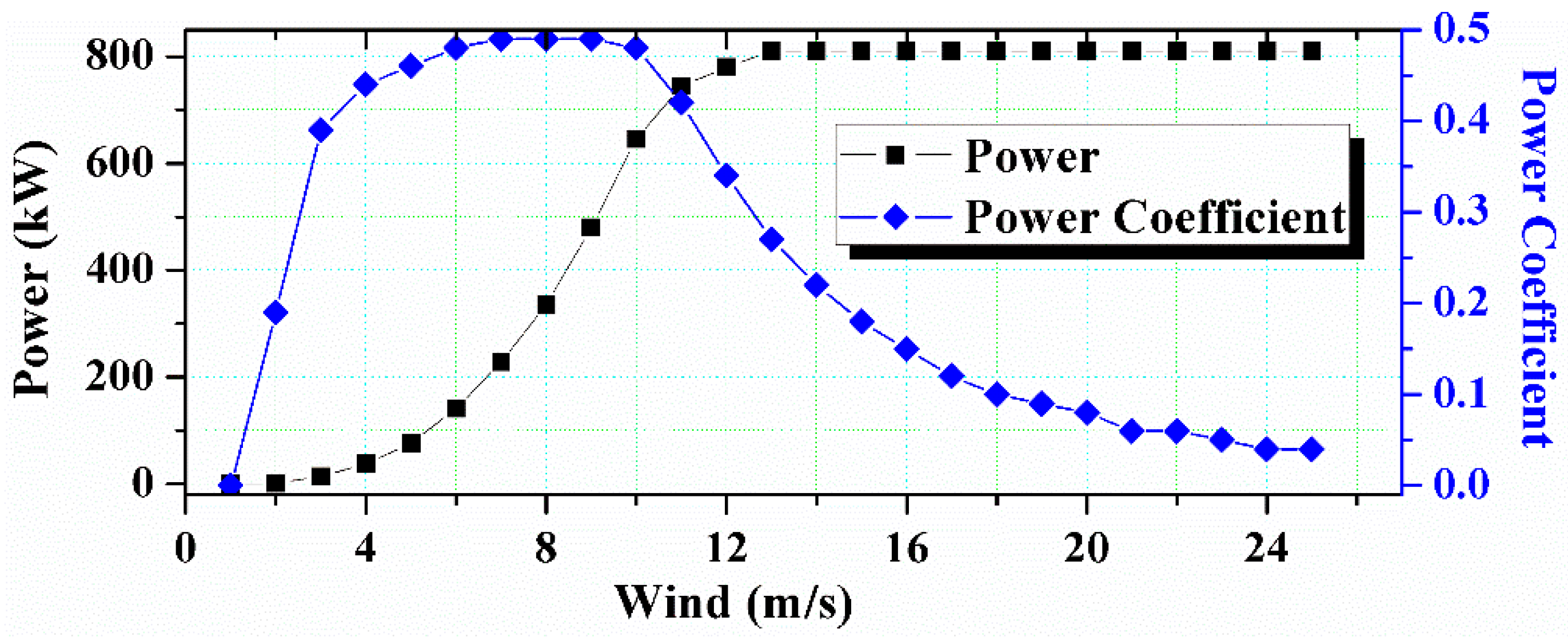
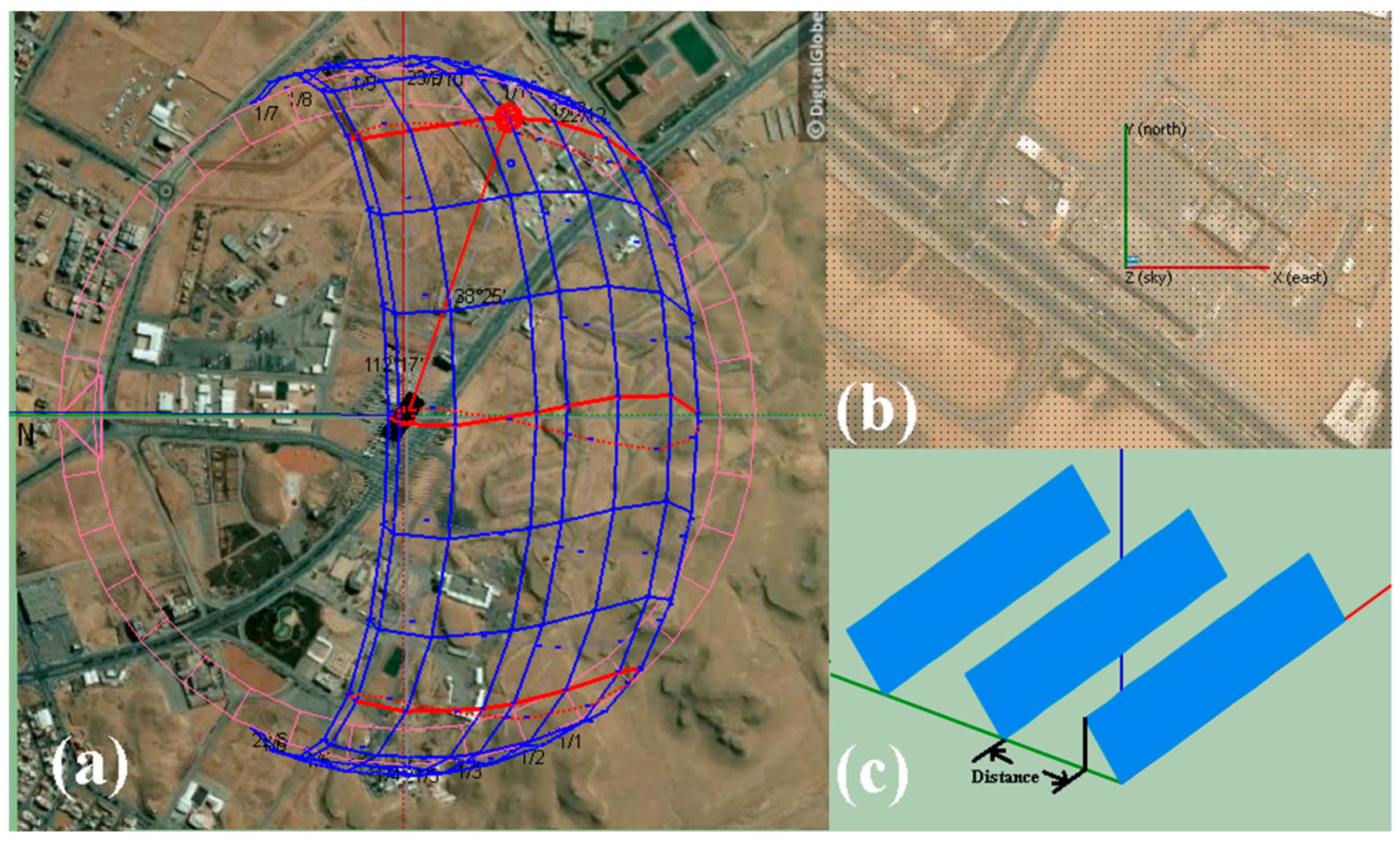
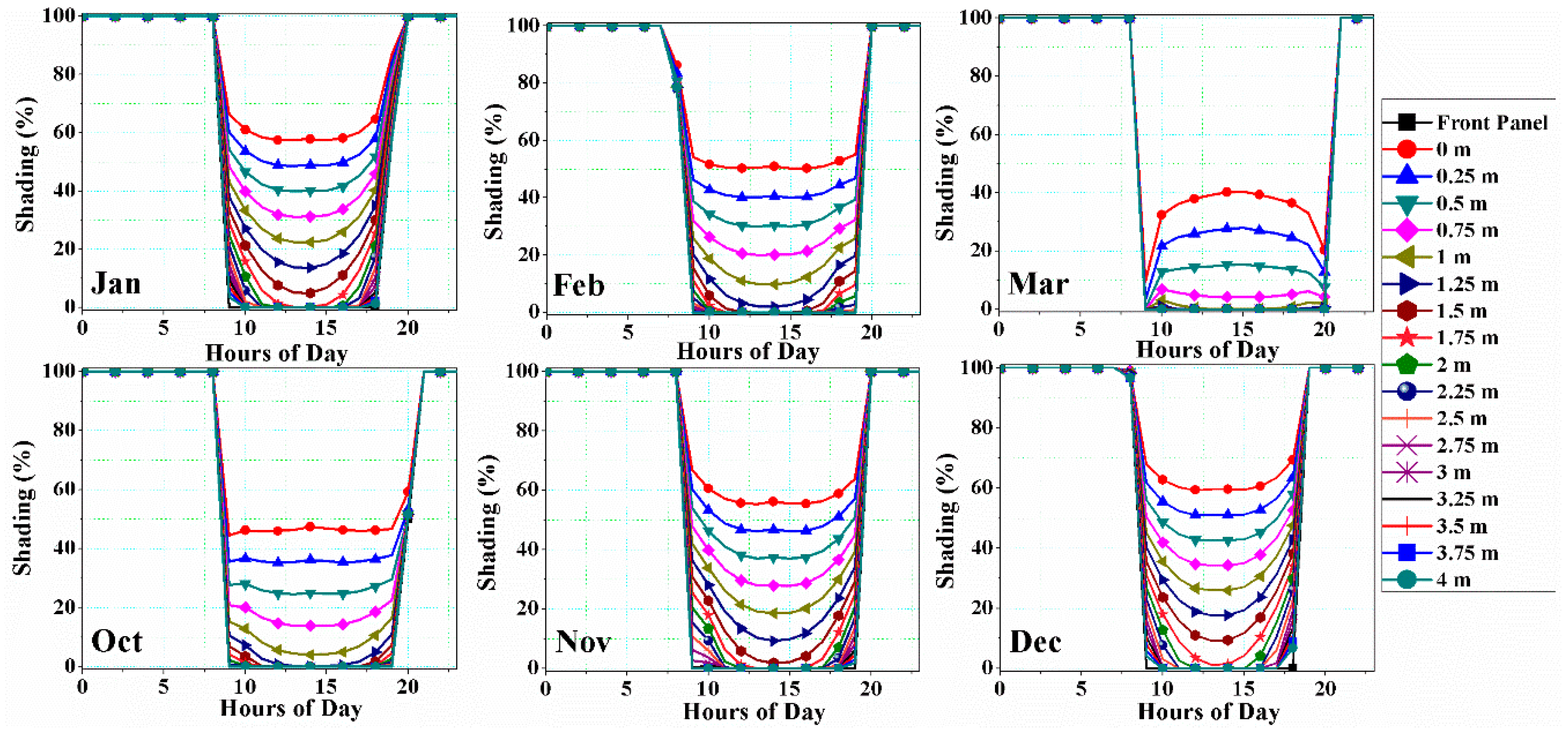


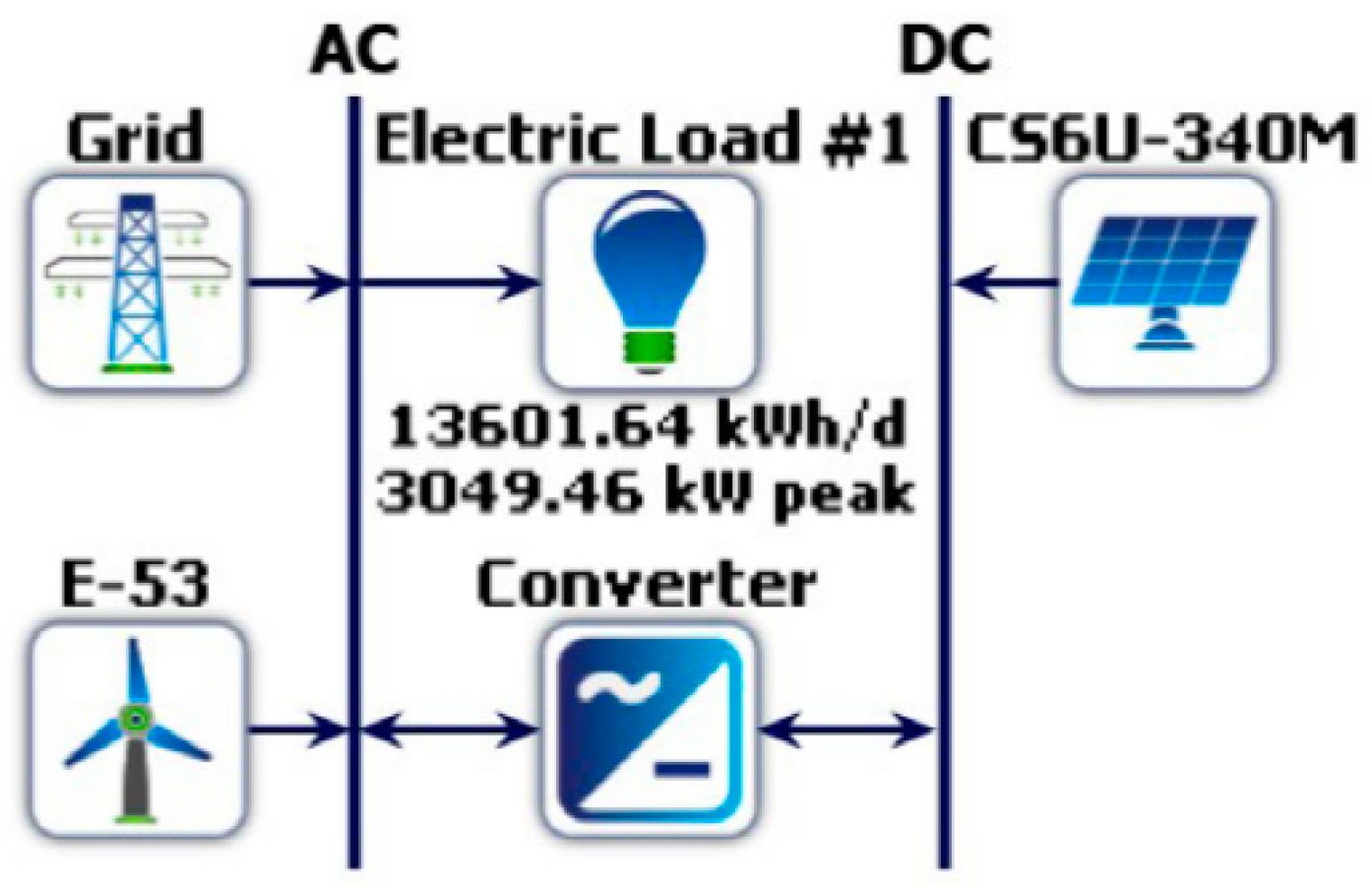



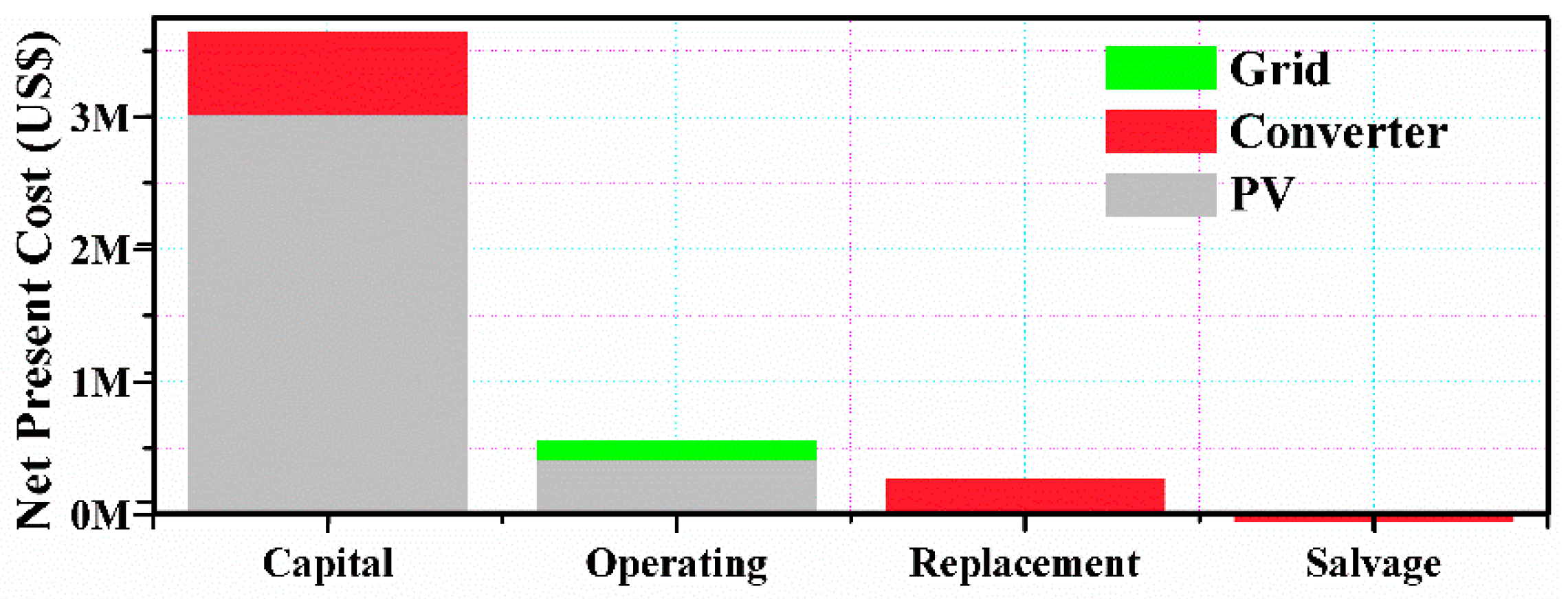
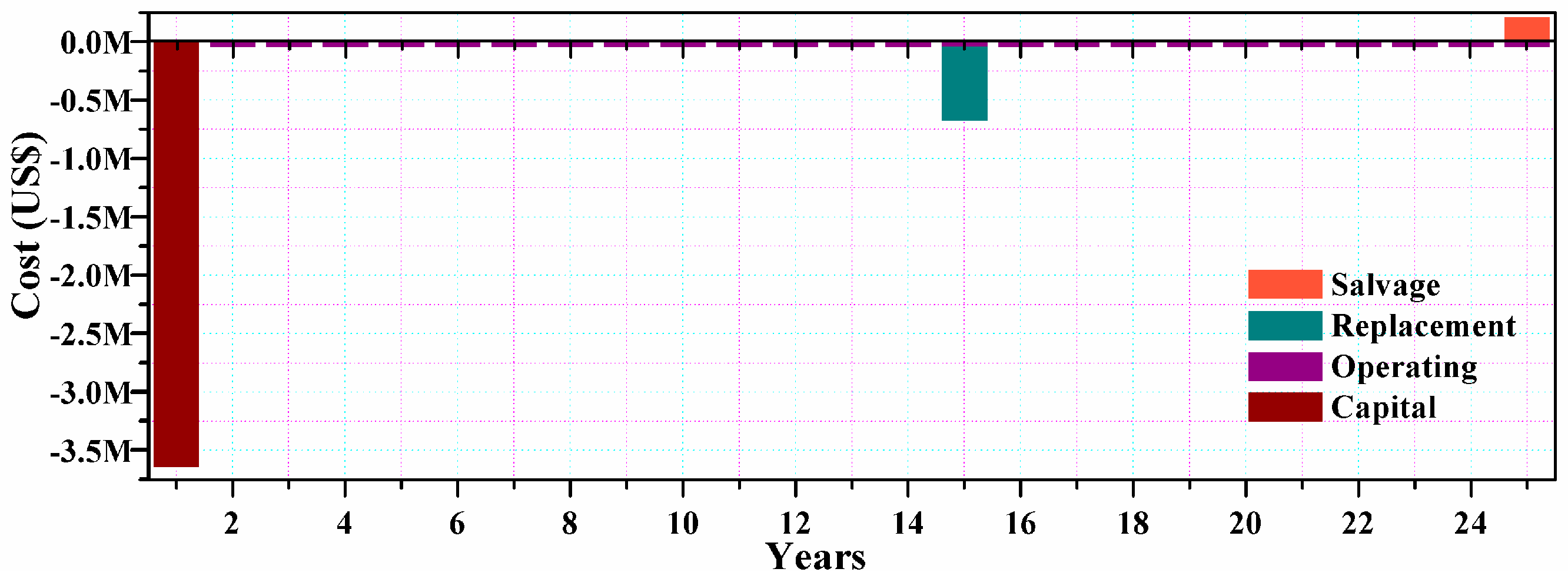
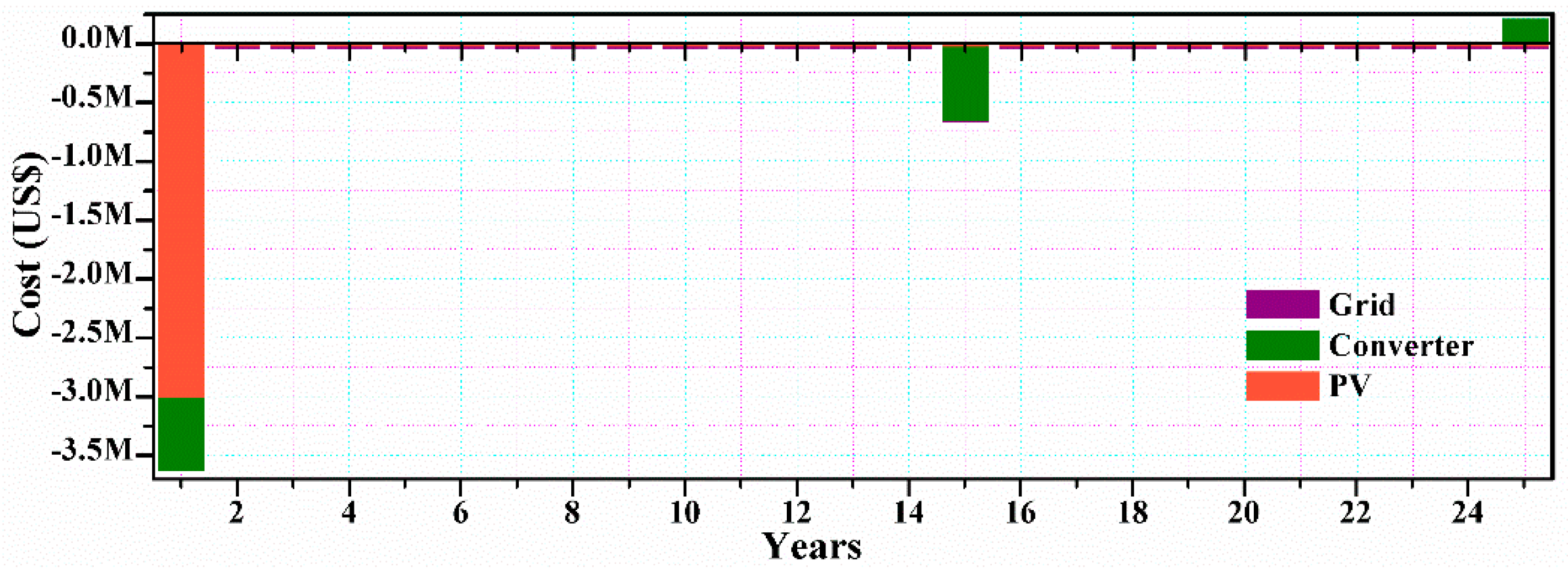
| Jan. | Feb. | Mar. | Apr. | May | Jun. | Jul. | Aug. | Sep. | Oct. | Nov. | Dec. |
|---|---|---|---|---|---|---|---|---|---|---|---|
| 51 | 43 | 29 | 13 | 0 | 0 | 0 | 6 | 23 | 39 | 48 | 53 |
| Parameter | Values | ||||
| Number of people/100 m2 | 5.382 | ||||
| Lighting Power Density | 10.7639 | ||||
| Electrical Equipment Power Density | 10.7639 | ||||
| Thermostat (Cooling) | 25.0 °C | ||||
| Thermostat (Heating) | 20.0 °C | ||||
| Exterior Wall | |||||
| Outside Layer | M01 100 mm brick | ||||
| Layer 2 | M15 200 mm heavyweight concrete | ||||
| Layer 3 | I02 50 mm insulation board | ||||
| Layer 4 | F04 Wall air space resistance | ||||
| Layer 5 | G01a 19 mm gypsum board | ||||
| Exterior Roof | |||||
| Outside Layer | M11 100 mm lightweight concrete | ||||
| Layer 2 | F05 Ceiling air space resistance | ||||
| Layer 3 | F16 Acoustic tile | ||||
| Interior Ceiling | |||||
| Outside Layer | M11 100 mm lightweight concrete | ||||
| Layer 2 | F05 Ceiling air space resistance | ||||
| Layer 3 | F16 Acoustic tile | ||||
| Exterior Window | |||||
| Outside Layer | Clear 3 mm | ||||
| Layer 2 | Air 13 mm | ||||
| Layer 3 | Clear 3 mm | ||||
| Window | |||||
| Thickness {m} | 0.003 | ||||
| Solar Transmittance at Normal Incidence | 0.837 | ||||
| Visible Transmittance at Normal Incidence | 0.898 | ||||
| Infrared Transmittance at Normal Incidence | 0 | ||||
| Conductivity {W/m-K} | 0.9 | ||||
| Office Lights Schedule | |||||
| Weekdays | Weekends | Holidays | |||
| Until: 05:00 | 0.05 | Until: 06:00 | 0.05 | Until: 24:00 | 0.05 |
| Until: 07:00 | 0.1 | Until: 08:00 | 0.1 | ||
| Until: 08:00 | 0.3 | Until: 12:00 | 0.3 | ||
| Until: 17:00 | 0.9 | Until: 17:00 | 0.15 | ||
| Until: 18:00 | 0.5 | Until: 24:00 | 0.05 | ||
| Until: 20:00 | 0.3 | ||||
| Until: 22:00 | 0.2 | ||||
| Until: 23:00 | 0.1 | ||||
| Until: 24:00 | 0.05 | ||||
| Office Equipment Schedule | |||||
| Weekdays | Weekends | Holidays | |||
| Until: 08:00 | 0.40 | Until: 06:00 | 0.30 | Until: 24:00 | 0.30 |
| Until: 12:00 | 0.90 | Until: 08:00 | 0.4 | ||
| Until: 13:00 | 0.80 | Until: 12:00 | 0.5 | ||
| Until: 17:00 | 0.90 | Until: 17:00 | 0.35 | ||
| Until: 18:00 | 0.50 | Until: 24:00 | 0.30 | ||
| Until: 24:00 | 0.40 | ||||
| Office Occupancy Schedule | |||||
| Weekdays | Weekends | Holidays | |||
| Until: 06:00 | 0.0 | Until: 06:00 | 0.0 | Until: 06:00 | 0.0 |
| Until: 07:00 | 0.1 | Until: 08:00 | 0.1 | Until: 18:00 | 0.0 |
| Until: 08:00 | 0.2 | Until: 12:00 | 0.3 | Until: 24:00 | 0.0 |
| Until: 12:00 | 0.95 | Until: 17:00 | 0.1 | ||
| Until: 13:00 | 0.5 | Until: 19:00 | 0.0 | ||
| Until: 17:00 | 0.95 | Until: 24:00 | 0.0 | ||
| Until: 18:00 | 0.3 | ||||
| Until: 20:00 | 0.1 | ||||
| Until: 24:00 | 0.05 | ||||
| Description | Cost | |
|---|---|---|
| Solar | EPC Cost (US$/MW) | 1,021,431 |
| PDC (US$/MW) | 36,658 | |
| IDC (US$/MW) | 10,714 | |
| Net Initial Cost (US$/kW) | 1068.80 | |
| O&M US$/kW/year | 7.82286 | |
| Insurance US$/kW/year | 3.37714 | |
| Wind | EPC Cost + PDC + IDC (MUS$/MW) | 1.93 |
| O&M (USC/kWh) | 1.1986 | |
| Insurance (USC/kWh) | 0.2523 | |
| Scenario | NPC | Capital Cost | LCOE | Installed PV | Installed Wind | System Converter | Batteries | Grid Sales | Grid Purchase | Renewable Penetration |
|---|---|---|---|---|---|---|---|---|---|---|
| MUS$ | MUS$ | (US$/kWh) | MW | MW | MW | Qty | GWh | GWh | % | |
| 1. Off-grid Hybrid | 26.1 | 17.5 | 0.3750 | 7.382 | 1.6 | 3.250 | 18,384 | - | - | 100 |
| 2. PV only (NS) | 4.77 | 3.95 | 0.0472 | 3.055 | - | 2.270 | - | 2.54 | 2.44 | 68.8 |
| 3. Wind only (NS) | 7.18 | 6.18 | 0.0658 | - | 3.2 | - | - | 3.06 | 2.72 | 67.8 |
| 4. Hybrid (NS) | 5.37 | 4.44 | 0.0550 | 2.238 | 0.8 | 1.670 | - | 2.17 | 2.17 | 71.2 |
| 5. PV (FS) | 4.41 | 3.64 | 0.0472 | 2.815 | - | 2.097 | - | 2.25 | 2.25 | 68.8 |
| 6. Hybrid (FS) | 5.00 | 4.14 | 0.0556 | 2.005 | 0.8 | 1.495 | - | 1.99 | 1.99 | 71.4 |
© 2018 by the authors. Licensee MDPI, Basel, Switzerland. This article is an open access article distributed under the terms and conditions of the Creative Commons Attribution (CC BY) license (http://creativecommons.org/licenses/by/4.0/).
Share and Cite
Zubair, M.; Bilal Awan, A.; Al-Ahmadi, A.; Abo-Khalil, A.G. NPC Based Design Optimization for a Net Zero Office Building in Hot Climates with PV Panels as Shading Device. Energies 2018, 11, 1391. https://doi.org/10.3390/en11061391
Zubair M, Bilal Awan A, Al-Ahmadi A, Abo-Khalil AG. NPC Based Design Optimization for a Net Zero Office Building in Hot Climates with PV Panels as Shading Device. Energies. 2018; 11(6):1391. https://doi.org/10.3390/en11061391
Chicago/Turabian StyleZubair, Muhammad, Ahmed Bilal Awan, Abdullah Al-Ahmadi, and Ahmed G. Abo-Khalil. 2018. "NPC Based Design Optimization for a Net Zero Office Building in Hot Climates with PV Panels as Shading Device" Energies 11, no. 6: 1391. https://doi.org/10.3390/en11061391
APA StyleZubair, M., Bilal Awan, A., Al-Ahmadi, A., & Abo-Khalil, A. G. (2018). NPC Based Design Optimization for a Net Zero Office Building in Hot Climates with PV Panels as Shading Device. Energies, 11(6), 1391. https://doi.org/10.3390/en11061391







